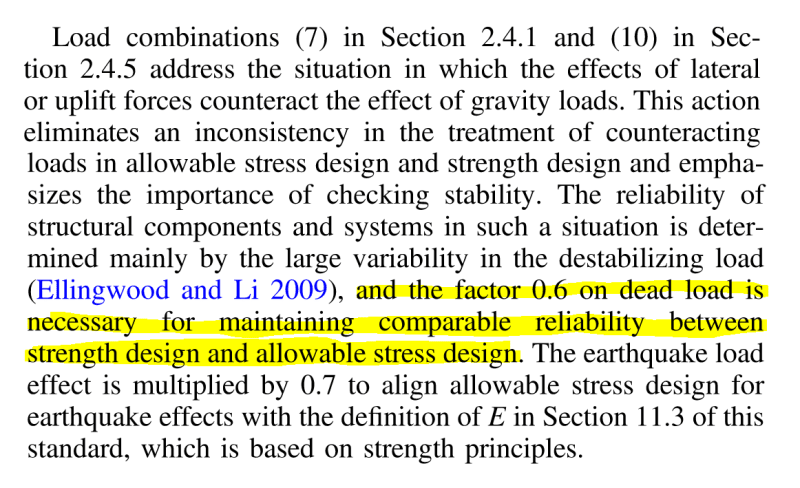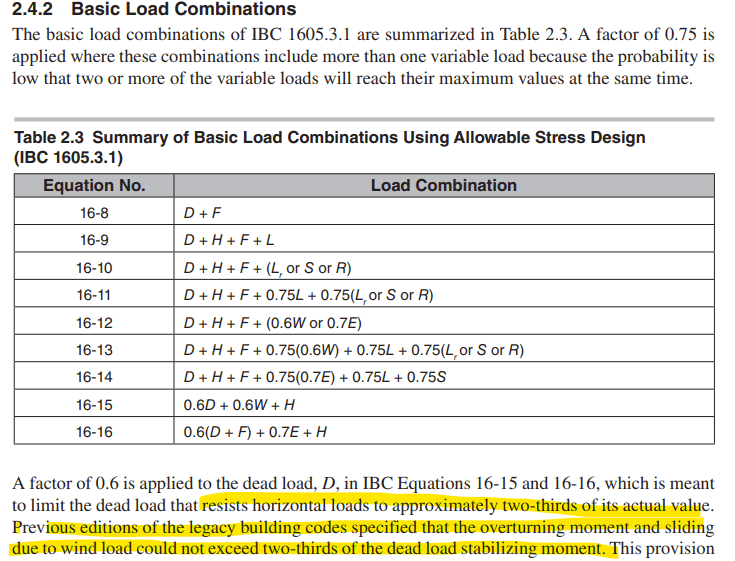KlunkerSolar
Structural
- Feb 24, 2016
- 4
So, this has probably been talked to death over the years but I can't find a thread that discusses this question fully. Should an engineer combine material factor of safety's (Ω in AISI, AISC, etc) with Building Code environmental load factors (ASCE 7-16, Section 2.4 ASD)?
Say I'm designing a steel column using ASD. AISC says my compression capacity is Pn/Ω (generally). I now go to my handy ASCE 7-16 load combinations to determine the ASD loads on the column.
Say I'm using the following load combination;
4 DL + SL)
DL + SL)
7 0.6DL + 0.6WL)
0.6DL + 0.6WL)
Now I'll set the equations;
EQ1)Pn/1.67 ≥ DL + SL
EQ2)Pn/1.67 ≥ 0.6DL + 0.6WL
In EQ1 it seems like we only applying a FOS to the left side of the equation. I'm dividing the Nominal Strength of the steel by 1.67 for a reduced capacity, but I'm not modifying the design loads in any. I've heard that the factor of safety on the right side is "the unlikely chance that both the full DL and SL will occur at the same time" but that isn't quantified in anyway or noted in the Code anyplace that I can find. Is that correct?
In EQ2 I'm still using a FOS of 1.67 for the material but I'm now also reducing the amount of DL resisting the WL by 40% (ignoring the 0.6 on the WL as the reduction from strength design to asd). This seems like a double-dip for the factor of safety although I can see the reasoning to apply a FOS to both. It leads to the question of "what is the total factor of safety I'm using here" and "is it higher than the FOS in EQ1"? Does it make sense to just use unfactored loads and rely on the material factor of safety (Ω) as adequate?
This made a lot of sense to me in my previous life designing building structures. I now live in the solar world where everything is designed to 99% stress levels and factor of safety for loads and materials are hot topics for debate. I keep getting questions around...."I know the weight (DL) of my structure very precisely so why can't I use 1.0DL in load combo 7." or "This is a low risk site (structure unoccupied, set low to the ground and fenced in) so I want to use an Ω = 1.5 for my material design".
Am I correct in my opinion that the left side and right side of EQ's 1 and 2 are independent of each other? In other words, the left side of the equation is based on the likelihood that the material properties are accurate, and the right side is based on the likelihood that the loads are accurate? I believe this is how LRFD is viewed, is it the same for ASD?
I appreciate any clarity I can get on the above. If possible, let's not get into a debate between LRFD and ASD and why one is better than the other, or some mathematical derivation on how they similar. Thanks in advance for any help!
Say I'm designing a steel column using ASD. AISC says my compression capacity is Pn/Ω (generally). I now go to my handy ASCE 7-16 load combinations to determine the ASD loads on the column.
Say I'm using the following load combination;
4
7
Now I'll set the equations;
EQ1)Pn/1.67 ≥ DL + SL
EQ2)Pn/1.67 ≥ 0.6DL + 0.6WL
In EQ1 it seems like we only applying a FOS to the left side of the equation. I'm dividing the Nominal Strength of the steel by 1.67 for a reduced capacity, but I'm not modifying the design loads in any. I've heard that the factor of safety on the right side is "the unlikely chance that both the full DL and SL will occur at the same time" but that isn't quantified in anyway or noted in the Code anyplace that I can find. Is that correct?
In EQ2 I'm still using a FOS of 1.67 for the material but I'm now also reducing the amount of DL resisting the WL by 40% (ignoring the 0.6 on the WL as the reduction from strength design to asd). This seems like a double-dip for the factor of safety although I can see the reasoning to apply a FOS to both. It leads to the question of "what is the total factor of safety I'm using here" and "is it higher than the FOS in EQ1"? Does it make sense to just use unfactored loads and rely on the material factor of safety (Ω) as adequate?
This made a lot of sense to me in my previous life designing building structures. I now live in the solar world where everything is designed to 99% stress levels and factor of safety for loads and materials are hot topics for debate. I keep getting questions around...."I know the weight (DL) of my structure very precisely so why can't I use 1.0DL in load combo 7." or "This is a low risk site (structure unoccupied, set low to the ground and fenced in) so I want to use an Ω = 1.5 for my material design".
Am I correct in my opinion that the left side and right side of EQ's 1 and 2 are independent of each other? In other words, the left side of the equation is based on the likelihood that the material properties are accurate, and the right side is based on the likelihood that the loads are accurate? I believe this is how LRFD is viewed, is it the same for ASD?
I appreciate any clarity I can get on the above. If possible, let's not get into a debate between LRFD and ASD and why one is better than the other, or some mathematical derivation on how they similar. Thanks in advance for any help!


![[jester2] [jester2] [jester2]](/data/assets/smilies/jester2.gif) ! You can determine your overall factor of safety at the end by simply going back and checking your unfactored loads against your capacity you determined using the load factors. The overall "global" factor of safety basically varies in LRFD.
! You can determine your overall factor of safety at the end by simply going back and checking your unfactored loads against your capacity you determined using the load factors. The overall "global" factor of safety basically varies in LRFD. 